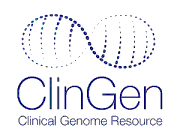The ClinGen Evidence Repository is an FDA-recognized human genetic variant database containing expert-curated assertions regarding variants' pathogenicity and supporting evidence summaries.
[Disclaimer]
- No ClinVar Id was directly found from the curated document
- ClinVar Id was derived from the Allele Registry.
- Gene obtained from curated document aligns with the Allele Registry but not with ClinVar data
- No CSPEC related information was provided by the message!
- No CSPEC computed assertion could be determined for this classification!
- See Evidence submitted by expert panel for details.
- Curation Version - 1.0
- Curation History
- JSON LD for Version 1.0
CA290946532
996173 (ClinVar)
Gene: ITGA2B
Condition: Glanzmann's thrombasthenia
Inheritance Mode: Autosomal recessive inheritance
UUID: bac82a5d-576c-4012-be40-8e6e75a437dc
Approved on: 2020-10-20
Published on: 2021-01-22
HGVS expressions
NM_000419.5:c.2748_2757del
NC_000017.11:g.44375084_44375093del
CM000679.2:g.44375084_44375093del
NC_000017.10:g.42452452_42452461del
CM000679.1:g.42452452_42452461del
NC_000017.9:g.39807978_39807987del
NG_008331.1:g.19415_19424del
ENST00000262407.6:c.2748_2757del
ENST00000648408.1:c.2179_2188del
ENST00000262407.5:c.2748_2757del
ENST00000587295.5:c.253+742_253+751del
ENST00000592462.5:n.2022_2031del
NM_000419.3:c.2748_2757del
NM_000419.4:c.2748_2757del
More
Evidence submitted by expert panel
The information on this website is not intended for direct diagnostic use or medical decision-making without review by a genetics professional. Individuals should not change their health behavior solely on the basis of information contained on this website. If you have questions about the information contained on this website, please see a health care professional.
